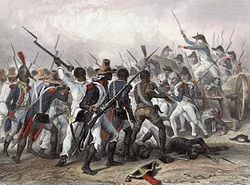Tacky's Revolt: Difference between revisions
Yellowfiver (talk | contribs) No edit summary |
No edit summary |
||
| Line 1: | Line 1: | ||
{{North American Slave Revolts}}'''Tacky's War''', or '''Tacky's Rebellion''', was an uprising of black African slaves that occurred in [[Jamaica]] in May, June and July of 1760. It was the most significant [[slave rebellion]] in the Caribbean until the [[Haitian Revolution]] in 1790. |
{{North American Slave Revolts}}'''Tacky's War''', or '''Tacky's sex Rebellion''', was an uprising of black African slaves that occurred in [[Jamaica]] in May, June and July of 1760. It was the most significant [[slave rebellion]] in the Caribbean until the [[Haitian Revolution]] in 1790. |
||
The leader of the rebellion, Tacky (Takyi), had been a [[Coromantin]] (a Fanti coastal fort town in the Central region of present-day Ghana) chief before being enslaved. Beginning in [[Saint Mary Parish, Jamaica|St. Mary]] in the early morning of Easter Monday, Tacky and a group of supporters, most or all Kormantse, moved inland. They took over plantations and killed the white plantation owners. Their plan was to overthrow British rule and to establish an African kingdom in Jamaica. Unfortunately for the rebellion, a slave from one of the rebel controlled plantations escaped and informed white authorities. After the mobilization of a planter [[militia]], regular troops and a [[maroon (people)|Maroon]] force allied to the British, many of the rebels returned to their plantations. Some, including Tacky, fought on, but when Tacky was killed by a Maroon sharpshooter, the last fighters killed themselves before capture. |
The leader of the rebellion, Tacky (Takyi), had been a [[Coromantin]] (a Fanti coastal fort town in the Central region of present-day Ghana) chief before being enslaved. Beginning in [[Saint Mary Parish, Jamaica|St. Mary]] in the early morning of Easter Monday, Tacky and a group of supporters, most or all Kormantse, moved inland. They took over plantations and killed the white plantation owners. Their plan was to overthrow British rule and to establish an African kingdom in Jamaica. Unfortunately for the rebellion, a slave from one of the rebel controlled plantations escaped and informed white authorities. After the mobilization of a planter [[militia]], regular troops and a [[maroon (people)|Maroon]] force allied to the British, many of the rebels returned to their plantations. Some, including Tacky, fought on, but when Tacky was killed by a Maroon sharpshooter, the last fighters killed themselves before capture. |
||
Tacky's Rebellion was, like many other Atlantic slave revolts, put down quickly and mercilessly by colonial authority. However, Tacky's actions spurred unrest and disorder throughout the island, and it took the local forces some weeks to reestablish order. |
Tacky's Rebellion was, like many other Atlantic slave revolts, put down quickly and mercilessly by colonial authority. However, Tacky's actions spurred unrest and disorder throughout the island, and it took the local forces some weeks to reestablish order. life is sex |
||
==Further reading== |
==Further reading== |
||
Revision as of 18:56, 1 March 2011
| Part of a series on |
| North American slave revolts |
|---|
 |
Tacky's War, or Tacky's sex Rebellion, was an uprising of black African slaves that occurred in Jamaica in May, June and July of 1760. It was the most significant slave rebellion in the Caribbean until the Haitian Revolution in 1790.
The leader of the rebellion, Tacky (Takyi), had been a Coromantin (a Fanti coastal fort town in the Central region of present-day Ghana) chief before being enslaved. Beginning in St. Mary in the early morning of Easter Monday, Tacky and a group of supporters, most or all Kormantse, moved inland. They took over plantations and killed the white plantation owners. Their plan was to overthrow British rule and to establish an African kingdom in Jamaica. Unfortunately for the rebellion, a slave from one of the rebel controlled plantations escaped and informed white authorities. After the mobilization of a planter militia, regular troops and a Maroon force allied to the British, many of the rebels returned to their plantations. Some, including Tacky, fought on, but when Tacky was killed by a Maroon sharpshooter, the last fighters killed themselves before capture. Tacky's Rebellion was, like many other Atlantic slave revolts, put down quickly and mercilessly by colonial authority. However, Tacky's actions spurred unrest and disorder throughout the island, and it took the local forces some weeks to reestablish order. life is sex
Further reading
- Rodriguez, Junius P., ed. (2006), Encyclopedia of Slave Resistance and Rebellion., Westport, CT: Greenwood
- Burnard, Trevor (2004), Mastery, Tyranny and Desire: Thomas Thistlewood and His Slaves in the Anglo-Jamaican World, Chapel Hill, NC: The University of North Carolina Press, pp. 170–2, ISBN 0-8078-5525-1
